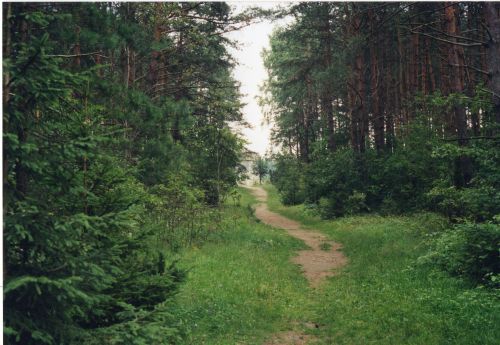The Tube

Treblinka 2002 - The site of the former Tube (Chris Webb Private Archives)
The Tube, or in German Der Schlauch was a camouflaged passage approximately 80-90 meters long, which started behind the barracks where the women undressed in the Lower Camp. There was a sign above its entrance which read, 'To the Showers (Zur Badeanstalt) which was close to the undressing barracks. The SS called it derisively 'The Road to Heaven (Himmelstrasse).
Ukrainian SS-Trawniki-manner Alexander Yeger testified on April 2nd 1948, about the 'Tube,' with its cashiers hut:
'Naked and shorn they then went down a narrow path bordered with barbed wire, past the "cashiers".
In the barracks where the citizens of Jewish nationality were undressed, they were told that they must hand over all their valuables and money to the "cashier" and that after they leave the bath house, the valuables would be returned to them. And so, passing by the "cashier's booth" the prisoners handed over all their valuables to the "cashier's booth", where a German, especially appointed for this purpose, received them. First the women and children and then the men were hustled pas [sic] the "cashier's booth". Men and women who resisted were chased past the "cashier's booth" in one group. When the women passed by it, some of them tried to hide their valuables, but the Germans standing by the "cashier's booth" examined them cynically and took away their valuables.
Having passed the cashiers, the prisoners came to a special building without windows and were led in. The inside of the building had the appearance of a bathhouse with separate cabins on both sides of a corridor. Here the prisoners were pushed in already by force into the chambers'.
Jankiel Wiernik, a Jewish survivor from the Treblinka death camp also recalled the cashiers hut:
'Next all the men, and women, old people and children had to fall in line and proceed from Camp No. 1 to the gas chambers in Camp No.2. Along the path leading to the chambers there stood a shack in which some official sat and ordered the people to turn in all their valuables. The unfortunate victims, in the delusion that they would remain alive, tried to hide whatever they could. But the German fiends managed to find everything, if not on the living, then later on the dead. Everyone approaching the shack had to lift his arms high and so the entire macabre procession passed in silence, with arms raised high, into the gas chambers.
Oskar Strawczynski, another Jewish survivor also described 'The Tube,' in his book 'Escaping Hell in Treblinka' :
'Behind the gate, we find ourselves in quite a large square with barracks on two sides. Opposite the fence and the gateway through which we had passed is a fence with a small entrance in the corner. This is the gate to the 'Avenue of Death,' which leads to the 'baths' in Camp 2. Down this avenue completely naked, they took their last walk: my dear wife and children, father, mother, brothers and sisters, together with millions of Jewish men and women.... They never came out of the 'bath.' Their sacred bodies were heaped on stretchers and thrown into the infernal fires.
Later, when i was working on the rooftops of Treblinka, I had many opportunities to watch that last walk of our naked, unfortunate people. Mothers holding their little ones in their arms, older children at their sides, young girls with their hair already shorn, covering their breasts with their hands; or several together, arms linked, all running as quickly as possible through the row of Germans and Ukrainians who laugh at them and mock them. Quite often, one or another of the victims was struck on the head with a whip or rifle butt and collapsed in a stream of blood. Those were horrible scenes from hell.'
Chil Rajchman recounted in his book 'Treblinka - A Survivors Memory' published in 2011,
'Opposite the platform where the barracks stand begins the road to the gas chambers, known as the Schlauch. The road is planted with small trees and looks like a garden path. Down this road, which is covered with a layer of white sand, all must run naked. No-one returns from this road. People driven down this road are beaten mercilessly and stabbed with bayonets, so that after they have been driven down it, the road is covered in blood.
A special commando, known as the Schlauch -Kolonne, cleans the road after every transport. They spread fresh sand, so that the next victims will be unaware. The Schlauch road is not long. In a few minutes you find yourself in a white structure, on which a Star of David is painted. On the steps of the structure stands a German, who points to the entrance and smiles - 'Bitte, Bitte!' The steps lead to a corridor lined with flowers and with long towels hanging on the walls.
Sources
Peter Laponder, Re-Constructing Treblinka, Unpublished Work 2000
Oscar Strawczynski, Escaping Hell in Treblinka, Yad Vashem, Jerusalem 2007
Samuel Willenberg, Surviving Treblinka, Basil Blackwell, Oxford 1989
Chris Webb and Michal Chocolaty, The Treblinka Death Camp, Ibidem-Verlag, Stuttgart 2021
Chil Rajchman, Treblinka, Maclehose Press Quercus, London, 2009
Photograph : Chris Webb Private Archive
© Holocaust Historical Society October 18, 2024

